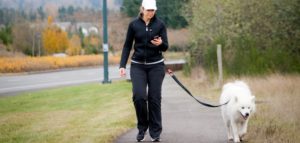If you saw our article on the top ways people get injured by their dogs, you will know that almost all of them involve the leash and several involve trying to hold the leash while doing something else – carrying items, texting, drinking coffee, etc.
Hands-free leashes can help reduce the risk of injury, but they have to be used properly, and some styles are better than others, depending on your size and your dog’s size/temperament.
Picking a Hands-Free Leash
When choosing a leash, here are some things to consider:
- Does my dog pull? If so, where is the best point of attachment? For example, if you only weigh 120lbs, and you have a 90lbs dog that pulls, attaching him around your waist is asking for you to get yanked off your feet.
- Do I need to be able to quickly shorten the lead? Most hands-free leashes give the dog a lot of freedom. If you have a reactive, untrained, or overly friendly dog, you will want to choose a style that allows you to quickly shorten the leash if necessary and/or allows you to choose how long the lead is.
- Do I want an all-in-one leash, or do I want to use my current leash? There are different types depending on if you want one complete system, or something that attaches to a leash you already have.
- Do I have more than one dog? If you plan on using a hands-free with more than one dog (which I would only recommend with smaller and well-trained dogs) then I would suggest using a coupler so you still only have leash to deal with.
- Does my dog weigh more than me? If so, a hands-free leash may not be a good option for you, unless your dog is very well trained.
Top Hands-Free Leashes
Here are my picks for hands-free leashes that I have personally used. There are others out there, but I find these ones work well and I like their versatility.

Mendota Jaegar Lead – this lead is nice and long, 8’, made of soft leather and can turn into just about any type of leash you want: over-the-shoulder hands-free lead, around your waist hands-free, short and long lead, slip lead, and even as a tie-out when you are at a coffee shop or something. (www.gundogsupply.com)
Dutch Dog Design Buddy Hands-free Leash Connector – this cool item is versatile because you can put it pretty much anywhere and then clip your leash(es) to the carabineer. Some of the ways it can be used: attach to your belt, backpack, belt loop, or it can be used with a bike frame attachment.(www.amazon.com)
Mendota Versa Belt Lead – if you wear belts a lot, this attachment is great (feature photo). You can attach it to your belt and unlike a lot of hands-free leashes, your dog is kept on a shorter lead, so control is easy. And you can quickly take your dog off the attachment if necessary. (www.dogsunlimited.com)
Safety Tips
- Only use a hands-free leash with a well-trained dog that knows what loose-leash walking is.
- Pay attention to your dog and your environment. For example, if your dog chases squirrels, you should be paying enough attention to be able to grab the lead if they start to take off so you don’t get pulled off your feet.
- Don’t over-fill your hands. As mentioned above, you may need to grab your dog’s leash if he starts to run, lunges at someone, or gets in the way of traffic. If your hands are full, you are going to be in trouble.
- Be Respectful. Most of these leashes give your dog a lot of extra freedom. Be watchful and make sure your dog is not pestering other walkers, getting into people’s yards, etc.
- Watch the lead. Your dog can still trip you or other people! Your dog should know to stick one side of your body (no switching sides which is a leading cause of tripping) and to stay close to your side so you don’t clothesline anyone.
Related: Best Dog Leashes
About the Author
Based in Wilsonville, Ore., animal lover Kristina N. Lotz is a Certified Professional Dog Trainer – Knowledge Assessed (CPDT-KA) and works as a full time trainer. She is the founder of, A Fairytail House, a unique all-positive all-sport dog training facility that helps rescue dogs in her area and provides free seminars and training classes for the community. In her spare time, she trains and competes in herding, agility, obedience, rally, and conformation with her Shetland Sheepdogs. She smartly married a Veterinary Technician, who helps keep the fur kids happy and healthy, and provides a quick resource for articles.
 Toledo, United States.
Toledo, United States.